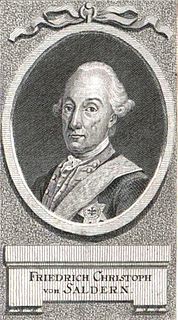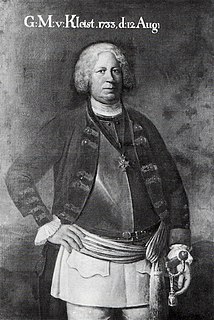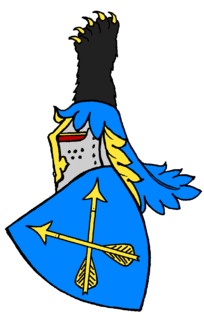
Friedrich Christoph von Saldern was a Prussian general and military writer. He proved his organizational mettle with the battlefield clean up after Liegnitz in 1760. At the Battle of Torgau he proved his tactical and command mettle in the assault Austrian lines, which changed the course of the battle. His refusal to sack Hubertusburg in 1763 led to his resignation from the army. Despite retirement from command, however, Frederick the Great promoted him to lieutenant general and made him inspector of troops. Saldern wrote at least two missives on infantry tactics. He received the Order Pour le Mérite and the Order of the Black Eagle; in 1851, his name was included on the Equestrian statue of Frederick the Great.

Friedrich Wilhelm von Dossow was a Prussian Generalfeldmarschall and Governor of Wesel.

Johann Jakob von Wunsch (1717–1788) was soldier of fortune and Prussian general of infantry, and a particularly adept commander of light infantry. The son of a Württemberg furrier, he served in several armies in the course of his lengthy career.
Franz Kasimir von Kleist was an infantry general of the Kingdom of Prussia. In 1806 as Governor of Magdeburg he capitulated to Napoleon's troops, for which he was posthumously condemned to death.

John Adolph of Nassau-Usingen was Count of Saarbrücken and Saarwerden and Lord of Lahr, Wiesbaden and Idstein. He served as a colonel in the French army and later in the royal Prussian army as Major-General and as chief of the Fusilier Regiment No. 47.

Jean de Forcade de Biaix, aka Jean de Forcade, Marquis de Biaix, aka Jean-Quirin de Forcade de Biaix, aka Jean Quérin von Forcade, Herr von Biaix, aka Johann Querin de Forcade, Herr zu Biaix, aka Johann Quirin von Forkade de Biaix was a Huguenot, a descendent of the noble family of Forcade and Lieutenant General in the service of the Kingdom of Prussia. He was the Regimentschef of the 23rd Prussian Infantry Regiment, Commandant of the Royal Residence in Berlin, Gouverneur militaire of Berlin, a Knight of the Order of the Black Eagle a member of King Frederick I of Prussia's "Tobacco Collegium". and President of the Grand Directoire 1718-1729, the deliberative and decision-making body responsible for all Huguenot affairs in the kingdom.

Friedrich Wilhelm Quirin von Forcade de Biaix, baptized Quirin Frideric de Forcade, aka Friedrich Quirin von Forcade, aka Frédéric Quérin de Forcade was a Royal Prussian Lieutenant General, the second son of a Royal Prussian Lieutenant General, an early Huguenot immigrant to Brandenburg-Prussia and a descendent of the noble family of Forcade. He was one of King Frederick the Great's most active and most treasured officers. He was wounded three times and once left for dead on the battlefield. Together with his wife, he fathered 23 children.
Isaac de Forcade de Biaix, aka Isaak de Forcade de Biaix, aka Isaac von Forcade de Biaix, aka Isaac von Forcade, aka Peter Isaac von Forcade, aka Isaak von Forcade, was a Royal Prussian colonel, Hofmarschall to the Prince of Prussia and recipient of Prussia's highest military order of merit for heroism, Knight of the Order of Pour le Mérite. He was a descendant of the noble family of Forcade in Béarn, born as a Roman Catholic, but emigrated to Brandenburg-Prussia at a young age, where he joined the Huguenot community in Berlin.
Friedrich Heinrich Ferdinand Leopold von Forcade de Biaix, aka Heinrich Friedrich Ferdinand Leopold von Forcade de Biaix, aka Friedrich Heinrich Ferdinand Leopold Marquis de Forcade de Biaix, was a Royal Prussian lieutenant colonel. He served in the Prussian Army from 1761-1793. His last command was as Commanding Officer of the 10th Prussian Fusilier Battalion, with which he served in the Rhine Campaigns of 1791, where he was awarded the Kingdom of Prussia's highest military order of merit for heroism, Knight of the Order of Pour le Mérite (1791). He left the Prussian Army after 32 years of service in 1793 as the result of invalidity. At the time of his death, he was the owner of Schleibitz Manor, near Oels, Silesia.
Friedrich Wilhelm Leopold Konstantin Quirin Freiherr von Forcade de Biaix, aka Friedrich Wilhelm Leopold Konstantin Quirin von Forcade de Biaix, Herr of Schleibitz, Hamm, Groß-Naedlitz and Loslau, aka the Baron von Forcade,, Royal Prussian Major, Knight of the Iron Cross 2nd Class on 26 August 1813, knighted by His Majesty Frederick William III of Prussia as Knight of the Order of Saint John in 1817, Royal Prussian Chamberlain (Kammerherr) and Castellan (Drost) of Neuenrade in the County of Mark, after his father's death in 1808. He was also a publisher, author, and theater director.
Friedrich Wilhelm von Forcade de Biaix, aka Frideric Guillaume de Forcade was a Royal Prussian Colonel, Schwadronschef of the 2nd Grenadier Company in the 24th Prussian Infantry Regiment, recipient of the Kingdom of Prussia's highest military order of merit for heroism, Knight of the Order of Pour le Mérite (1774), Commandant of Frankfurt/Oder, and Presbyter of the French congregation of Frankfurt/Oder.
Friedrich Wilhelm Ferdinand Ernst Heinrich von Forcade de Biaix, aka Ferdinand von Forcade, Royal Prussian Major and Knight of the Iron Cross 2nd Class.

Henning Alexander von Kleist (1676/77–1749) was an 18th-century Prussian field marshal. He fought in the War of Spanish Succession, the Great Northern War, and in the Wars of Austrian Succession. In particular, his actions at the Battle of Mollwitz brought him acclaim, although he had long been a stalwart supporter of Prussian military developments by the Prussian kings Frederick (1740–1786) and Frederick William I (1713–1740).

Friedrich Sigmund von Waldow was royal Prussian Major General, Chief of the Cuirassier Regiment no 8 and hereditary lord of Mehrenthin.

Christoph II, Burggraf and Count of Dohna-Schlodien was a Prussian general. He was the son of Christopher I, Burgrave and Count of Dohna-Schlodien (1665–1733). He served in the armies of Frederick William I of Prussia and his son, Frederick II, in the Silesian and Seven Years' wars. He was particularly successful at the Battle of Gross-Jägersdorf, and instrumental in relieving Siege of Kolberg.

Heinrich Sigismund von der Heyde was a Prussian officer and commander-in-chief of Kolberg. His name is spelled variously "von der Heyden" and "von Heyden". He is best known for his tenacious defense of Kolberg during its three sieges of the Seven Years' War. He received the Pour le Merite and he is immortalized on the Equestrian statue of Frederick the Great.

Gustav Bogislav von Münchow was a Prussian general. In the early years of the reign of Frederick the Great, Münchow was not only a soldier and a diplomatic confidant, but he also earned a reputation for the improvement of Prussian military medical care. He was honored with the Black Eagle Order and his name is listed on the Equestrian statue of Frederick the Great.
Karl Ferdinand von Hagen, also called Karl Ferdinand von Geist, was a Prussian major general and chief of Infantry Regiment No. 8. He died from injuries received at the Battle of Hochkirch

Peter Ernst von Pennavaire ], was the son a French advocate (attorney) in Toulouse, who had fled from France in about 1685. He served in Prussian army, achieving the rank of lieutenant general of cavalry and proprietor of the Leib-Carabiniers. He was the recipient of both the Black Eagle Order and Pour le Mérite. At the Battle of Breslau, when he was 80 years old, he led his cavalry in a charge at the Austrian front. He died of complications from injuries received at the Battle.

Soloman Sprecher von Bernegg, born in Chur, Canton Grisons, 14 December 1697 – 14 September 1758 Aussig, Bohemia was a Habsburg military commander in the War of Austrian Succession and the Seven Years' War.
















